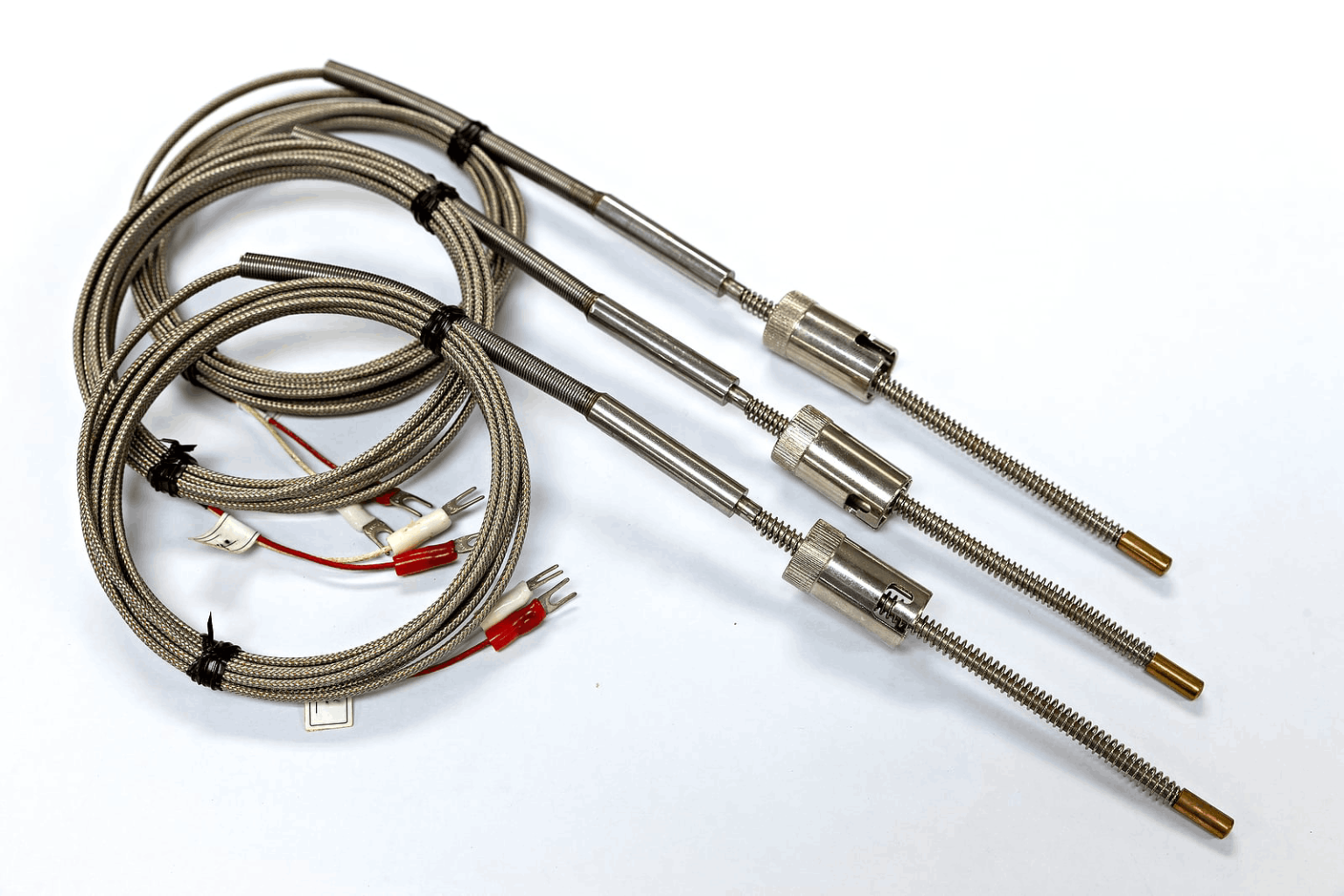Platinum thermocouples are temperature sensors used in various types of scientific instruments and in laboratory settings to provide accurate temperature readings. When they reach the end of their useful life, thermocouples become scrap equipment, often destined for landfills.
If you have scrap thermocouples, don’t discard them! Instead, learn how to identify those containing platinum and sell them to AU Precious Metals. We pay top dollar for unwanted platinum, including scrap platinum thermocouple wire and other components.
Types of Thermocouples and Platinum Models
Thermocouples come in various types which use different materials to measure temperatures across specific ranges. For example, a Type T thermocouple contains copper and constantan, an alloy of copper and nickel.
The likelihood of a thermocouple containing platinum increases with its temperature range. Platinum’s exceptionally high melting point of 3214.9°F, where other metals would melt, makes it ideal for high-temperature applications. Thermocouples designed for high temperatures include:
- Type B. A Type B thermocouple can be used to measure temperatures ranging between 32°F and 3,100°F. It contains two conductors; One lead is 94% platinum and 6% rhodium. Where the other lead is 70 % pt and 30 % rhodium.
- Type R. The Type R thermocouple can handle temperatures of -58°F to 2,700°F. Like Type B, Type R’s conductors use platinum and rhodium in their construction. One conductor uses a platinum/rhodium 13% alloy, while the other is pure platinum.
- Type S. Type S thermocouples are rated to handle temperature ranges of -58°F to 2,700°F or up to 3,096°F in short periods. One of the leads is a platinum/rhodium 90/10 and the other is .999 platinum.

How to Recognize a Platinum Thermocouple
You may be wondering how to differentiate scrap thermocouples containing platinum from those that don’t. Scrap platinum thermocouples and wires generally have distinctive features and markings to help scientists and laboratory personnel distinguish them from other types.
Without labels indicating their type, you can use other visual cues to identify your thermocouples. The colors of the positive wires, negative wires, and jackets often vary based on their type and the country they originate from. Additionally, they might have a two- or three-letter cable code, which can help determine their type.
Typical platinum thermocouples feature the following indicators:
| Type and Country | Positive Wire Color |
Negative Wire Color |
Jacket color | Cable code |
| Type B, United States | Gray or silver | Red | Gray or silver | BX |
| Type B, International | Gray or silver | White | Gray or silver | BX |
| Type R, United States | Black | Red | Green | RCA |
| Type R, International | Orange | White | Orange | RCA |
| Type S, United States | Black | Red | Green | SCA |
| Type S, International | Orange | White | Orange | SCA |
Source: https://www.sterlingsensors.co.uk/thermocouple-types-chart
How Much Platinum Do Thermocouples Contain?
The amount of precious metals in platinum thermocouples varies based on their design, wire diameter, wire length, and specific type. For Types B, R, and S thermocouples. This allows you to estimate the quantities of platinum and rhodium present based on the thermocouple’s type.
For example, Type B platinum thermocouples have one wire with a platinum/rhodium 6% alloy, meaning this wire is 94% platinum. The other wire uses a platinum/rhodium 30% alloy, meaning it is 70% platinum. Therefore, an entire Type B thermocouple contains approximately 82% platinum and 18% rhodium.
If you have a Type B scrap thermocouple weighing a total of 0.25 troy ounces, it contains approximately 0.205 troy ounces of platinum and 0.045 troy ounces of rhodium. As of December 4, 2023, the spot prices for each metal were:
Had you sold a 0.25-troy-ounce Type B scrap thermocouple on that date, it would have contained approximately $187.92 in platinum and $198 in rhodium, bringing its total potential value to $385.92.
How to Sell Your Platinum Thermocouples for the Best Price
After determining which of your thermocouples contain platinum, your next step is to locate a buyer interested in purchasing them. To maximize the return on your scrap thermocouples, consider visiting AU Precious Metals.
Here are a few reasons why you can place your trust in us:
- We accept platinum scrap thermocouples. Although some precious metal buyers might not accept thermocouples or scientific scrap, we welcome them. You can bring your scrap thermocouples to us for analysis and valuation.
- We use non-destructive analysis equipment. We use X-ray fluorescence (XRF) scanners to accurately analyze all precious metal items, including thermocouple wires. This method is precise and non-destructive, enabling us to provide you with an exact estimation of the composition of your thermocouples.
- We pay a fair price. Our team uses the most recent spot prices to offer you value estimates, guaranteeing you receive the most competitive and fair price for your scrap thermocouples.
- We offer a mail in program. If visiting one of our locations in person isn’t feasible, you can use our mail in program. Follow our guidelines to sell your scrap platinum thermocouples and get an estimate without leaving your home. We’ll ensure you get paid quickly if you are satisfied with our offer. We’ll even absorb the shipping costs if your thermocouples are worth $5,000 or more.
Sell Scrap Platinum at AU Precious Metals
As a dependable and reputable precious metal dealer in the Detroit area, we specialize in converting your scrap platinum thermocouple wire into cash. You can visit us at our Rochester location or get in touch with us with questions or for more information about our services.


